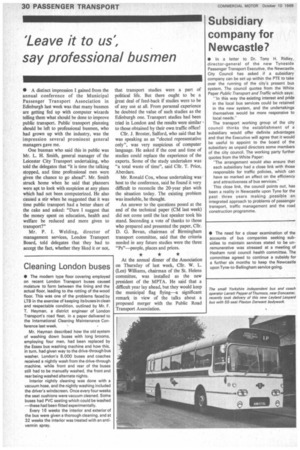Cleaning London buses
Page 32

If you've noticed an error in this article please click here to report it so we can fix it.
• The modern type floor covering employed on recent London Transport buses caused moisture to form between the lining and the actual floor, leading to the rotting of the wood floor. This was one of the problems faced by LTB in the exercise of keeping its buses in clean and respectable condition, outlined by Mr. F. T. Heyman, a district engineer of London Transport's road fleet, in a paper delivered to the International Cleaning Maintenance Conference last week.
Mr. Heyman described how the old system of washing down buses with long brooms, employing four men, had been replaced by the Essex bus washing machine and how this, in turn, had given way to the drive-through bus washer. London's 8,000 buses and coaches received a nightly wash from the drive-through machine, while front and rear of the buses still had to be manually washed, the front and rear being washed alternate nights.
Interior nightly cleaning was done with a vacuum hose, and the nightly washing included the driver's windscreen. Once every four weeks the seat cushions were vacuum cleaned. Some buses had PVC seating which could be Washed —these had been fitted experimentally.
Every 16 weeks the interior and exterior of the bus were given a thorough cleaning, and at 32 weeks the interior was treated with an antivermin spray.
























































































































